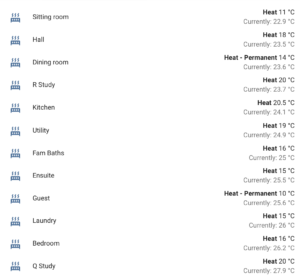Rose and I are still playing low-tech Wordle from time to time. She came rather close to defeating me yesterday: her word was ‘Hydra’. Very slippery. Took me quite a while to kill that one.
Category Archives: General
How to deal with criticism
Esther Bintliff has a splendid (longish) piece in the FT entitled, “Feedback required: the science of criticism that actually works“. She begins:
Years ago, after I received some negative feedback at work, my husband Laurence told me something that stuck with me: when we receive criticism, we go through three stages. The first, he said, with apologies for the language, is, “Fuck you.” The second is “I suck.” And the third is “Let’s make it better.” I recognised immediately that this is true, and that I was stuck at stage two.
These three stages seem to be somewhat universal, and many people, she points out, never even make it as far as stage two, and get hung up at the angry response. But you can only benefit from feedback if you get through both of those stages to the third.
Depending on your personality, you may be more likely to stay at stage one, confident in your excellence and cursing the idiocy of your critics. The problem, Laurence continued, is being unable to move on to stage three, the only productive stage.
Now, this is simple, memorable, and worthy of regular contemplation, and the article would have been useful if it stopped there. But no, there’s plenty more good stuff to come.
How, for example, should you ask for feedback if you actually want people to give it to you?
How might your feedback be presented in a way that helps others to get to stage three?
How is this connected to The West Wing?
And how often is any sort of feedback actually worthwhile? What about those regular performance reviews that so many businesses undertake? She talks about when Avraham Kluger met Angelo DeNisi, both researchers in this area..
When Kluger told him he was studying the destructive effects of feedback on performance, DeNisi was intrigued. “My career is based on performance appraisal and finding ways to make it more accurate. You’re telling me the assumptions are incorrect?” he asked. “Yes, I’m afraid I am,” replied Kluger.
The two reviewed hundreds of feedback experiments going back to 1905. What they found was explosive. In 38 per cent of cases, feedback not only did not improve performance, it actively made it worse. Even positive feedback could backfire. “This was heresy,” DeNisi recalls.
I think this is another example of very enjoyable and informative journalism from the FT, but it is behind their paywall, so I shouldn’t reproduce too much of it here.
Too financial for our times?
The problem with the FT is that it is really quite expensive as online publications go. £1 or so per day does add up over the year, and makes it more expensive, for example, than Netflix, Spotify and Disney+ combined. Bizarrely, you can have them deliver a paper version through your door each day for somewhat less than even their basic digital access package.
If, however, you are rather wealthy, or, like me, you’re fortunate enough to be associated with an organisation that pays for FT access, then I would suggest it’s a perk well-worth exploring. (The iPad app is also good, and lives on my home screen.)
If not, I guess you can keep an eye on the headlines and pop to the newsagent if you see something that piques your interest. Remember newsagents? I guess they’re not just for cans of San Pellegrino — they’re a useful alternative to bits of the internet that are too expensive.
In the meantime, I have a small number of gift links I can use to give non-subscribers access to the article, so get in touch if you’d really like to read the rest of it.
There! That should get me some nice feedback.
Home Automation for Heat Waves
 As we face record high temperatures in the UK today and tomorrow, it seems likely that climate change may bring us more of these in the future, so my first job over breakfast today was to write a little script for my Home Assistant-based home control system that sets all the blinds on the east- and south-facing windows to be 70% closed. We’ve never used them before to keep sunlight out in the middle of the day, but they work rather well.
As we face record high temperatures in the UK today and tomorrow, it seems likely that climate change may bring us more of these in the future, so my first job over breakfast today was to write a little script for my Home Assistant-based home control system that sets all the blinds on the east- and south-facing windows to be 70% closed. We’ve never used them before to keep sunlight out in the middle of the day, but they work rather well.
A bit later, as temperatures in my upstairs study were still getting rather high, I started to think about the radiators. Why? Well, we have smart thermostatic valves on all of them, which report back the temperature in each room. Normally, of course, this is so that each room can be heated to the right level for the time of day. (I have a separate schedule for each room, which is modified automatically based on things like whether there are guests in the guest room, or whether Rose’s phone is detected in her office in town rather than her study at home, or whether we’re watching TV in the evening.)
But I hadn’t really thought of making use of this data in the summer, until today, when I realised I could easily sort all my rooms in order of increasing temperature. A quick new view added to my control panel showed that yes, indeed, my study was currently the warmest room in the house, and the sitting room was the coolest:
So it would be much more sensible to go and work from the comfort of the sofa, rather than from my desk.
As a result, this comes to you from the sitting room, and I have successfully improved my comfort level. As you can tell, though, I don’t think it actually resulted in me doing more work…
Re-branding question for the day…
I’ve been wondering… When did a ‘rug’ or ‘blanket’ or ‘bedspread’ become a ‘throw’?
From the John Lewis website: this is a throw:
And this is a bedspread:
Was it when British heating and insulation reached the point when you no longer needed blankets to wrap around humans, and so they just had a decorative role?
I suspect this coincided with a trend towards plainer, less-patterned furniture, and so you needed something to add a splash of contrasting colour.
And why ‘throw’, anyway? When do you throw ’em and when do you spread ’em? Is it a marketing ploy by manufacturers to encourage you to use on sofas those product that you might previously have reserved for picnics or chilly bedrooms, but in either case would probably just have involved spreading?
Anyway, I suspect ‘throw’ to be something of an aspirational statement: the idea that you casually cast these things around, but the combination of your good aim and your good taste means that they’ll make your home look like something out of Country Life.
My next line of fashionable home decor accessories will include the ‘Quilted Scrumple’ and the ‘100% Highland Wool Chuck’, for those whose tastes tend to the even more casual. Only this with a really good eye and throwing arm, though, will be able to get the best out of my ‘Chenille Hurl-across-the-room’.
In touch with the tech…
My friend Pilgrim Beart publishes a monthly email newsletter covering topics from IoT, electric vehicles, clean and smart energy.
I like the format: generally just a list of one-sentence bullet points with links to relevant articles elsewhere. Very easy to skim and find items of interest. You can see back issues here to give you an idea, and sign up here to have it in your inbox each month.
Amongst the many things I learned over breakfast today:
In the UK, electric vehicles are now estimated to have one-third of the carbon footprint of their combustion-powered equivalents over their lifetime. (This is partly because of the ever-greener UK power network, one of the few recent national achievements we can be proud of at present!)
There’s a new Raspberry Pi designed for embedding in things: the Pico W. It addresses the issue I’ve always had with devices like the Arduino and the earlier Pico: no built-in network connectivity. For me, devices are usually only interesting if they’re networked, and much of my home automation depends on devices containing the wifi-enabled ESP8266 and ESP32 devices – smart plugs & relays, energy monitors etc. At $6, the Pi team are clearly aiming at this market with the new device. They’ll need to enable its Bluetooth capabilities soon, though, if they want people to build devices supporting the new Matter protocols, which I think has a good chance of being a very important cross-vendor standard in the near future.
Bloomberg predicts that VW’s EV sales will overtake Tesla’s in 18 months’ time. This can only be a good thing. Much as I love my Tesla, I’ve also been a big fan of VW for decades, and am delighted to see them reborn, Gandalf-like, in whiter raiment than they had before. They (and all car manufacturers) do need major work on their software, though: when I tried the ID-3 a couple of years ago, I found significant bugs even in my 15-min test-drive. Perhaps it has improved since then. If they don’t get a good handle on this, a lot of manufacturers are going to have to buy their software from Apple. I have to say that a VW with Apple software is something I would find very tempting…
Happy feet
I hope it makes you smile too!
Brunch with Brent
Amongst the tech podcasts I enjoy while driving, dog-walking, etc are the ones from Jupiter Broadcasting.
The Self-Hosted show, in particular, discusses topic and news of interest to those who like to run some of their own IT infrastructure rather than outsourcing it all to third parties. It covers areas like backups, VPNs, media servers, and home automation (one of my current hobbies)!
Linux Unplugged keeps me in touch with Linux news. Even though I’ve been a heavy user of Linux since the days when it was first released as two floppy disk images, and I run and manage a large number of Linux servers, both personally and professionally, I haven’t really used it as my desktop operating system since Apple’s release of MacOS X gave me a Unix-based alternative, so this helps keep me in touch with developments there as well as on the back-end.
Anyway, I recommend these if you’re interested in such geeky topics; I think they’re nicely produced.
And then there’s Jupiter Extras, a feed with a range of interviews and other stuff that doesn’t really fit into any of the other streams. One of the Jupiter hosts, Brent Gervais, has a set of periodic interviews labelled ‘Brunch with Brent’, and I was delighted to be invited to join him for one of these a little while ago (published yesterday), in which he let me ramble on about everything from scuba diving to the patent system, from QWERTY keyboards to self-driving cars.
The full discussion can be found on Episode 86, and there’s a shorter extract in the middle of the latest Linux Unplugged episode too.
Low-tech Wordle
Rose and I have taken to doing collaborative Wordle after dinner. As we finish off our glasses of wine, we pass the iPad to and fro, taking turns to fill out the next line.
The only trouble is that this enjoyable activity is rather short-lived; once you’ve done today’s puzzle, there isn’t another one, and you don’t end up with very many lines each!
So yesterday we got out some paper and took it in turns to pick a word for the other person to solve, which I can recommend as a fun variation.

Of course, I later remembered that my friend Richard was experimenting with this some months ago.
Note: in the original version of this post, I had accidentally spelled it as ‘Worldle’, which explains some of the comments below!
Un-Gmailing
Ah, nostalgia! I’ve been looking back at the first messages I sent right back in 2004 using the latest hot new web phenomenon: a beta version of the recently-announced GMail. (I had a friend who had a friend in Google, so got an invitation fairly early.)
They are mostly examples of literary brilliance such as:
Subject: Quick Test of Gmail
Let’s see how it works.
But later that day I had settled down a bit. Here’s an extract from a message I sent to John:
It’s a very nice webmail system, with an unusual amount of storage available per person (1G).
My concerns with the current beta are:(a) I have 0.7G of email already on other systems, so it wouldn’t be a complete solution for long, and
(b) it really is, at present, just a webmail system. It’s the nicest one I’ve used, but it has no IMAP or other access, and hence no way to export your email. Meaning that messages in Gmail can never be moved to another system. (Though there are some scripts out there which connect, parse the web pages etc)
I imagine they’ll have to add this in some form before too long, but I’m also sure they don’t want to make it too easy. In particular, they probably want to keep the browser as the main interface so they can control advertising around the email.
Back then, a free email account was pretty rare, and a free e-mail account that gave you a whole gigabyte of storage was amazing!
In the intervening 18 years, I’ve never used my Gmail address as my main account, but it has been handy as a backup. I forwarded copies of incoming messages there from my main account, for example, until I realised it was probably foolish: I was giving Google access to all of my life history without even making use of the free email service in return! But I am a big fan of some of the other Google services, and a heavy user of YouTube, Google Maps, and to a lesser extent Google Docs, so having a Google account has always been important. I even earn a little bit of pocket money from some of my YouTube videos.
I did like the early versions of Google Docs which actually let you edit the CSS used in rendering your document, so you could make it look just as you wanted! Sadly, that feature went away in 2010. And I’m conscious that Google products and features do have a tendency to vanish rather unexpectedly.
I expect the ones I’ve mentioned above are pretty safe, but this page is a nice reminder that the free product you depend on today may not be here tomorrow. 2022 is the tenth anniversary of the demise of Google Video, for example, and this blog used to have quite a few links to content there. That was probably pretty safe, wasn’t it? It had been around for seven years, after all! My golden rule about making sure you can get your data out of any system in a useful form, before putting too much of it in, is particularly applicable to Google products.
There’s no such thing as a free inbox
Anyway, the good news is that my Gmail messages are still around, and Google now give you 15x as much storage for free as they used to, but that’s not enough for the amount of old email I’ve been storing there. I’ve been paying a modest amount for Google One storage for the last couple of years, and that’s no bad thing: for a service to be sustainable, its true costs do need to be met somehow. Buy my subscription has just come up for renewal, and since I already pay for cloud storage in a couple of other places that don’t also use my data for other purposes, I’ve decided to thin down the amount of stuff I’ve been keeping on Gmail. My account isn’t going away, but it’ll just be a temporary space; all the important stuff will be sent elsewhere.
The good news is that Gmail did introduce support for IMAP a few years after my early messages, so moving my 17GB of Gmail messages over to join the 24GB in my main account is much more straightforward than it would otherwise have been! (There will be a lot of duplicates, and if you’re doing anything similar and are happy on the command line, you might find my IMAPdedup script useful to get rid of them.)
Lastly, even though I recognise and appreciate the innovation and usefulness of some of them, I’m very glad that I didn’t invest any serious time in any Gmail-specific features!
You may have seen my article a few months ago about why I, and a significant number of my colleagues, will no longer keep important data in our Cambridge University email accounts, for similar reasons.
Anyway, I’m trying to develop Quentin’s Golden Rules of Data Storage. Here’s an early draft of the first two:
-
The more important your data, the more open its storage format should be.
-
The amount of data you put into any proprietary system should be proportional to the ease of extracting it in a usable non-proprietary form.
P.S. You can use these nuggets of wisdom for free at the moment, but I don’t have a sustainable business model for them yet, so I may need to charge you gradually-increasing amounts for them in the future.
A Good Breeze
We had fun on Rutland Water on Friday.
Fixing the NHS problem
My parents live about 13 minutes’ drive from the nearest hospital. There’s also a more substantial one 20 mins away. Over the last few years, they have on several occasions needed to call an ambulance after falls and other serious issues, and the waiting time is always measured in hours; on a couple of occasions, more than eight hours.
This shocks me, but it shocks my American wife even more. When they had to call an ambulance for her mother in Michigan — a fairly regular occurrence in her later life — they would worry that something was wrong if it hadn’t arrived in twenty minutes, because normally it was there in about ten. For all the outrageous costs and several other failings of the American health system, there are some things it does do rather well.
The simplistic public response to the NHS problem is to blame under-funding. “It’s because of Tory cuts!” Here’s a graph that was popular on Twitter last year, for example, and looks pretty damning:

But let’s be clear about what this graph shows: this is expenditure growth, above the rate of inflation. In other words, since its foundation, every government has given the NHS significantly more money in real terms every year. Some have increased it faster than others, but there have never been any ‘cuts’, from Tories or anybody else. So, while more money is desirable, that’s not the primary problem.
(As an aside, we all love the story of Captain Tom Moore who so caught the public imagination by his sponsored walks around his garden between his 99th and 100th birthday that he raised a whopping £33M for the NHS, earning him a knighthood, an honorary doctorate and an RAF flypast on his 100th birthday. It was a great feel-good story during the pandemic, and I don’t want to take anything away from his achievement by pointing out that he, and all his millions of sponsors, funded the NHS for a total of about an hour and a half. The world would be a much better place with more Captain Toms in it, but a whole battalion of Toms are unlikely to make a significant difference to the NHS.)
Now, I’ve written before about some NHS experiences that have convinced me that serious administrative incompetence is the source of many of its issues. And, to the extent that proper funding is also needed, I pointed out, it simply requires us all to vote in a government that is going to charge us about £1000 more per family member per year, and earmark that exclusively for the NHS. The UK public has only very occasionally been given the option to do something like that, even on a more modest scale, and they have never voted for it.
So I was intrigued by John Burn Murdoch’s analysis in yesterday’s FT. (The page itself is probably behind a subscriber paywall.) He provides the usual worrying statistics about A&E and ambulance waiting times, but points out:
While the pandemic has undoubtedly created a shock in the UK’s publicly funded health system, the NHS’s underlying issues are chronic. Waiting lists for elective treatment have been lengthening for 10 years, and the target of keeping 95 per cent of A&E waits under 4 hours missed for just as long.
…
It would be easy to blame underfunding, but in 2019 the UK spent just over 10 per cent of GDP on healthcare, placing it among other wealthy western European countries. The trend over the past two decades has also aligned with comparable nations, according to the OECD.
The key problems, he suggests, are also not simply with staff shortages:
While the number of fully qualified permanent GPs in England has fallen by 8 per cent since 2009, that of hospital doctors has grown by a third, outpacing the growth of the elderly population that accounts for an outsized portion of hospital demand. Nurse numbers continue to grow despite more departures this year.
In other words,
… ever growing resources are being used to treat ever more sick people, but ever fewer are being used to prevent them from getting sick in the first place.
The UK ranks among the highest for admissions to hospital for some conditions which would, in other countries, be largely treated within primary healthcare. (I am reminded of my wife’s surprise that GP practices in the UK don’t generally have X-Ray machines: you have to go to hospital for a check on a minor fracture!)
Anyway, the first part of his proposed solution is that we need to rethink the balance between primary care and hospital care; this is more of an issue than overall funding levels.
And the second is that it’s easy to blame staff shortages, but studies have shown that A&E delays, for example, are primarily about physical capacity — especially bed capacity — in the rest of the hospital, and are not significantly affected by staffing levels.
In summary, he says,
Much like any chronic illness, the NHS’s afflictions will not be cured with a sticking plaster. The road to recovery is paved with long-term investment to upgrade the physical capacity of the system, and to gradually shift the balance from treatment in hospitals to primary and preventive medicine.
A nicely-written article, and one of the many reasons I would pay for an FT subscription if the university wasn’t kind enough to do so for me.
Update, about six months later: There’s a very interesting page at the BMA providing an overview of current health spending in the UK and how it compares to other countries, and to the past history of the NHS.
Just the job
A recent spam email in my inbox says:
I can set up a 15 minutes intro call with our Head of Customer Success if this email interests you.
Do people really have job titles as idiotic as “Head of Customer Success”? How would you live with yourself? Wouldn’t you cringe when anybody asked you your role? And what are you head of? A team of other little Customer Success people all the way down to Customer Success Trainees, perhaps? Would you hang your head in shame if one of your customers didn’t succeed at something?
Perhaps you could get away with never mentioning it, now that people don’t hand out business cards any more… until your company insisted on email signatures. Anyway, if you have that job title, I pity you… unless you asked for it.
Now, don’t get me wrong, I rather like fun job titles. I remember a friend who had ‘Software Artisan’ on his business card, for example, and it raised a smile, while still actually saying something. The problem with the one in my email was the nagging worry that they were actually serious about it.
At one of my previous startups, I described myself as the CIO – the Chief Interim Officer. I wrote the software until I hired somebody better; did a bit of hardware until we got a proper hardware guy, sold things until we hired a sales team, and ran the company until I found a better CEO… at which point I’d hired myself out of a job and it was time to go and start a new company. That’s the peril, or joy, of being a jack-of-all-trades and master of none.
And I remember long discussions at one lab over whether we should be described as ‘Research Scientists’ or ‘Research Engineers’. Those of us working mostly with the U.S. tended to prefer the former, because the ‘Research Scientist’ term was well-used there, and an engineer was the guy who came and fixed your washing machine. Those working more with other parts of Europe, where the term Engineer is often given the respect it deserves, preferred the latter, which was arguably a better description of what we actually did.
Have you ever had any really good, bad, controversial, or cringeworthy job titles? Let us know in the comments!
Our eventual solution at the lab, by the way, was simply to leave the job titles off our business cards completely, and let others work it out for themselves. Perhaps, if they made a good job of it, we could have applied for a transfer to the Customer Success department.
© Copyright Quentin Stafford-Fraser




Recent Comments